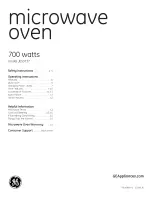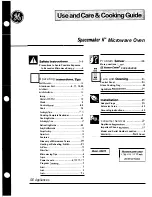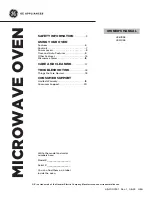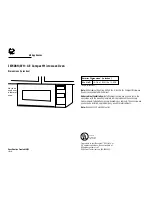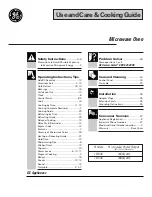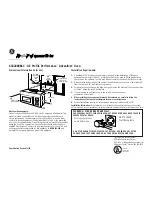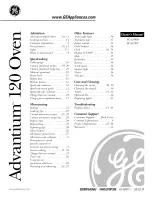
Section 4 Component Teardown
4-11
After any servicing, make sure of the following:
1. Door latch heads smoothly catch latch hook through
latch holes and that latch head goes through center
of latch hole.
2. Deviation of door alignment from horizontal line of
cavity face plate is to be less than 1.0mm.
3. Door is positioned with its face pressed toward
cavity face plate.
4. Re-install outer case and check for microwave
leakage around door with an approved microwave
survey meter. (Refer to Microwave Measurement
Procedure.)
Figure 4-4. Door Components
After any service to the door:
1. Make sure that door sensing switch and secondary
interlock switch are operating properly. (Refer to
section 3 “Test Procedures”.).
2. An approved microwave survey meter should be
used to assure compliance with proper microwave
radiation emission limitation standards.
NOTE
The door on a microwave oven is designed to act as an
electronic seal preventing leakage of microwave energy
from oven cavity during cook cycle. This function
does not require that door be air-tight, moisture-tight
or light-tight. Therefore, occasional appearance of
moisture, light or sensing of gentle warm air movement
around oven door is not abnormal and does not indi-
cate a leakage of microwave energy from oven cavity.
NOTE
Upper Door
Hinge Pin
Lower Door
Hinge Pin
Door Assembly
Tab
Tab
Hood Exhaust
Upper
Oven
Oven
Hinge
Hinge
Re-install
Re-install
Door Stopper
Lower
Latch Heads
Louver
Door Disassembly
Removal
1. Disconnect the power supply cord and remove the
oven from wall and remove outer case. (Refer to
procedure of “Removal of Oven from Wall” and
“Outer case Removal”)
2. Open the door and block it open.
3. To discharge high voltage capacitor, wait for 60
seconds.
4. Remove the three (3) screws holding the hood
exhaust louver to the oven cavity front face plate.
5. Remove hood exhaust louver from the oven cavity
by pushing the right and left tabs of the hood
exhaust louver.
6. Remove door assembly. Replacement of door
components are as follows:
7. Place door assembly on a soft cloth with latches
facing
up.
Choke Cover
8. Insert a putty knife (thickness of about 0.5mm)
into the gap A between the choke cover and door
stopper and between the choke cover and the door
frame as shown Figure 4-5 to free engaging parts.
9. Pry the choke cover by inserting a putty knife in
order shown in Figure 4-5.
10. Now choke cover is free from door panel and door
frame.
Door Frame Assembly
11. Remove two (2) screws holding the door panel to
the door frame assembly.
12. Release door panel from the door frame assembly.
13. Now, door frame assembly is free.
As engaging part of choke cover and door frame are
provided at 15 places, do not force any particular part.
NOTE
It is easier to release the engaging parts of the upper
or lower door hinge pin side at first.
NOTE
Summary of Contents for CFMV152KW
Page 2: ......
Page 18: ...Section 2 Operation 2 6 Notes ...
Page 51: ...Section 6 Parts List 6 3 Oven And Cabinet Parts ...























